Poker Hand Rankings: Use Skill and Strategy to Form the Hand
Texas Hold’em is the most popular poker variant in the US. It is also the ranking game internationally, dwarfing other poker games by a long margin. This Poker Hands Guide is based on Texas Hold’em hand rankings, and it will reveal the best-kept secrets to forming winning hand combinations. Unlike many other games, poker is a game of skill, wit, and strategy. Math and probability analysis play a big part in poker. The best poker players have a keen understanding of the numbers, but our intention in this guide is to simply provide you with an easy to understand way of compiling the best 5-card poker hand.
We know that you’re eager to get started, and the last thing you want is to be saddled with complex mathematics, probability analysis, and statistical gobbledygook. Here at 888poker USA, we get it. You just want to play poker. We would be remiss if we simply sent you out there into the competitive poker arena without the necessary schooling. That’s why we created this poker hand rankings guide. A little knowledge goes a long way, and it will help you gain a competitive edge over your opposition. There’s no escaping the fact that poker is a numbers game. The more you understand about these numbers, the more you can tilt the odds in your favor!
Poker School 101: Poker Hand Ranking Charts
We don’t want to fail in our basic duty of educating you about poker hand rankings. That’s why we’ve put together this comprehensive poker guide. Why are hand rankings so important? Without a basic understanding of starting hands in poker, you won’t know whether to Hold’em or Fold’em when you’re dealt a set of cards. For example, what comprises a strong starting hand? What’s a weak starting hand? Careful selection of starting hands goes a long way towards improving your poker game. If you know which poker hands to play in the pre-flop phase, and what hands to play in the post-flop phase, you are already leaps and bounds ahead of the competition. In fact, the foundation of your poker game is based on your understanding of the strength of your cards. It doesn’t matter whether you’re playing Omaha Hi-Lo, 7 Card Stud, or Texas Hold’em – the right selection of starting hands is paramount.
Poker players who take the time to study how to win with certain starting hands, will certainly gain an advantage over their opponents.
Texas Hold’em features 169 different starting hands. Despite this, there are only 9 categories of showdown hands available. In this poker hand ranking guide, we’re going to introduce you to the worst showdown hands and make our way up to the best showdown hands.
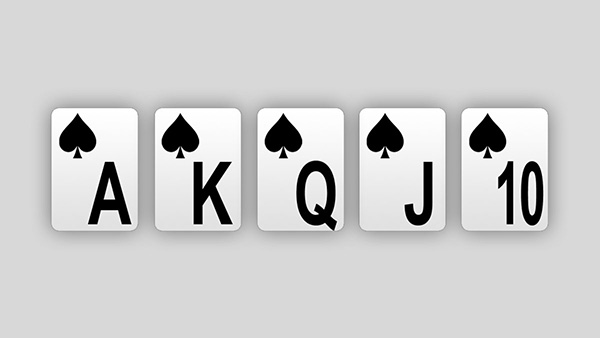
A Royal Flush
As far as poker hands go, it doesn’t get better than a Royal Flush! It consists of the following hand: 10-Jack-Queen-King-Ace. All the cards must be the same suit. It is a Straight Flush with all the Royals and an Ace, and no other hand can beat
this.
Remember, the best strategy to adopt is one which fuses pocket cards, the Flop, Turn and River to form the strongest 5-card hand.
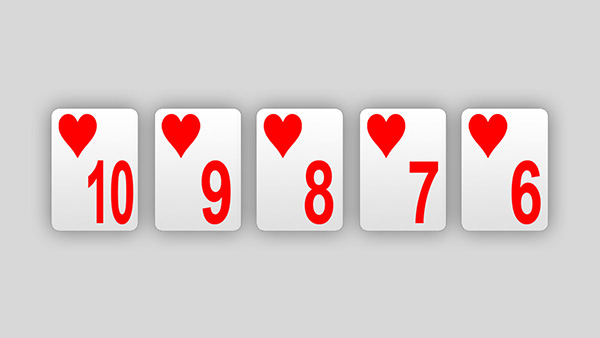
A Straight Flush
A Straight Flush is a rung beneath A Royal Flush. With a Straight Flush, the connected cards are in sequential order, all in the same suit. The lowest possible Straight Flush that you can form is 2, 3, 4, 5, 6. The highest possible Straight Flush you can form is 9, 10, Jack, Queen, King. You can form a straight flush through a combination of pocket cards and the board, and only a royal flush hand can beat this.

Four of a Kind
Four of a Kind is a strong hand also known as Quads. It’s extremely rare to form a hand with 4 identical cards of different suits. There are several ways to form quads. For example, you may have one card in your starting hand and there is a matching Trip on the board, or you have A Pair and there is another matching Pair on the board. The lowest Four of a Kind hand you can form is 4 Deuces (2s), and the highest ranking is 4 pocket rockets (Aces).
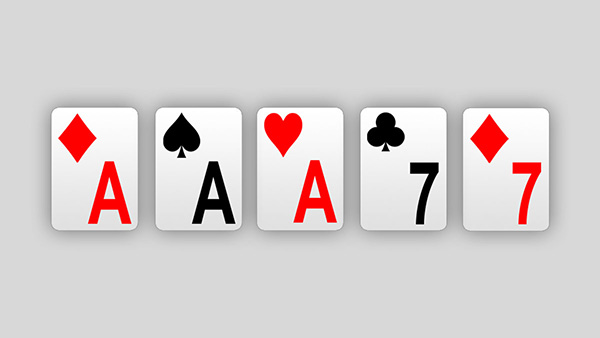
A Full House
A Full House includes 3 of a Kind, and A Pair. It doesn’t matter what (3+2 cards) you have to form a Full House. It ranks below four of a kind and above a flush. Of course, if you’re comparing Full Houses, then the strongest possible Full House you can form is 3 x Aces and 2 x Kings. The lowest ranking Full House you can form is a trip of 2s and a pair of 3s.
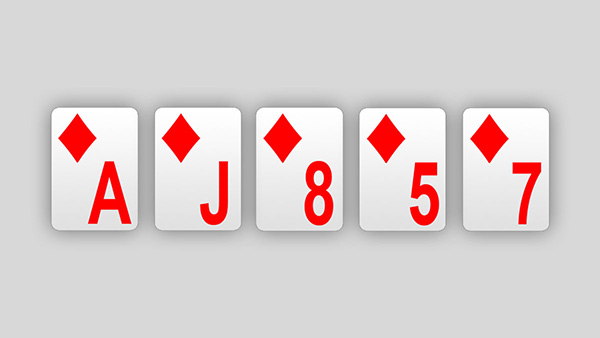
Flush
When you’re holding 5 cards from the same suit, you have what is known as a Flush. There are several ways to form a Flush. For example, you may be dealt 2 cards of the same suit in your starting hand, and 3 of the 5 community cards might be from the same suit as your starting hand. The highest possible Flush is the Ace-high Flush such as A♠J♠10♠3♠2♠. It’s interesting to point out that 2-4-5-K-A of clubs is the equivalent of 2-4-5-K-A of spades.

A Straight
A Straight includes 5 cards in consecutive order.
In the picture, you will notice 6, 7, 8, 9 & 10. That’s 5 cards in consecutive order. The higher the value of the Straight, the stronger it is. The strongest possible Straight you can form
is Ace, King, Queen, Jack and 10. The name for this is Broadway. The lowest winning Straight you can form is 5, 4, 3, 2, & Ace – the Wheel. While a Broadway Straight looks like a Royal Flush, they are completely different.
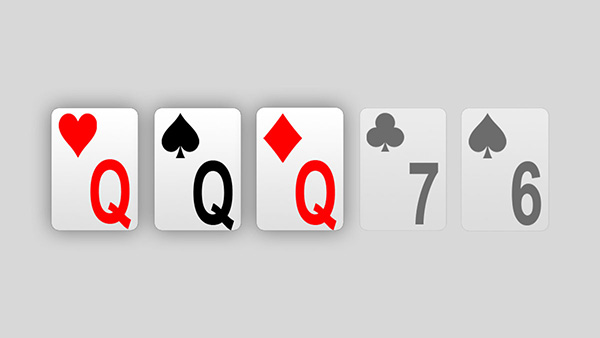
Three of a Kind
Three of a Kind beats Two Pair in Texas Hold’em and other poker games. It should be noted that there are two ways to form Three of a Kind in poker. Your starting hand may be a pair of Queens and the board brings you the third Queen. Alternatively, you could be dealt a single Queen in your starting hand, and a pair of Queens lands on the board, etc. Either way, you’ve got Three of a Kind, or a Trip.

Two Pair
Two Pair is an extremely common winning hand. The kicker card is the fifth card, and it comes into play if other players have identical pairs. The higher the kicker card the better for you. There are several ways to form two pairs. You may be dealt a pair in your starting hand, and the board may reveal the other pair. Or, you could be dealt a Jack and a 9 and the board may reveal another Jack and another 9, etc.
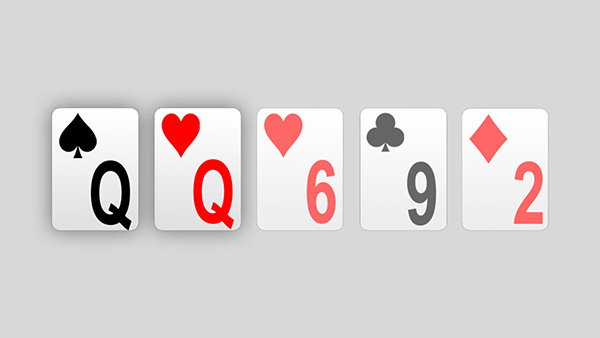
One Pair
This poker hand comprises a single pair, like a pair of Jacks, a pair of Tens, or a pair of Sevens. There are two ways to form one pair – you’re either dealt the cards in your starting hand (Queen of spades & Queen of hearts), or you have a Queen of hearts/Queen of spades and the board (The Flop, Turn, and River) features the other Queen. If the board features a pair of Queens, you can claim them as your own, but so can other players.
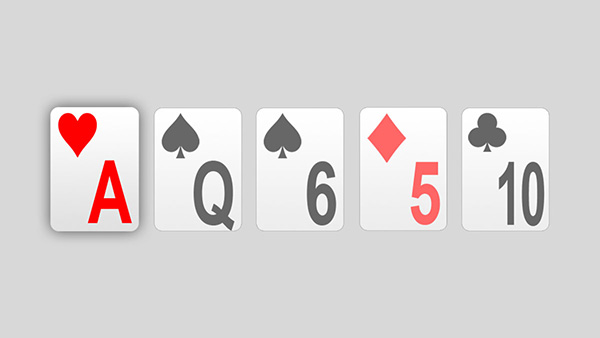
No Pair
Also known as the High Card hand, this is the lowest-ranking poker hand that you can form in Texas Hold’em. It’s so low, that you don’t even have a pair to work with. With this poker hand, your high card is an Ace and that beats a King high, or a Queen high hand etc.
The Holy Writ of Poker Hand Abbreviations
|
K10 or K-10 |
This hand consists of a King and a 10 |
|
Ah10s or Ah-10s |
This hand consists of an Ace of hearts and a 10 of spades |
|
A9s |
This hand consists of an Ace and 9 suited |
|
A10+ |
This consists of A-X hand with a kicker (fifth card) higher than 10 |
|
X, A-x or AX, A-X |
This is Ace and any other card |
|
JJ or J-J |
This represents Pocket Jacks, or a Pair of Jacks |
|
JJ+ |
This indicates that only pocket Jacks or better are permitted, including pairs of Queens, Kings, and Aces |
Evaluating the Strength of Starting Hands
Would you believe that there are 1,326 unique combinations of 2-hole card combinations in Texas Hold’em? It’s a fact! However, there are also 4 different suits in poker games, meaning that the actual number of non-equivalent cards is just 169. A starting hand made up of Ace of diamonds, King of diamonds (AdKd) is the same as Ace of hearts, King of hearts (AhKh). There are a total of 13 pocket pairs, 78 suited hands as well as 78 unsuited hands in that total number of 169. The best hand that you can start out with is a pair of pocket rockets (Ace-Ace). The worst possible starting hand that you can form is 3-2.
In Texas Hold’em and other poker games, the strength of your starting hand is an important determinant of your chances of winning by the time the Flop, Turn and River are dealt. It comes as no surprise that a Pair of Aces could win the pot without the community cards having much influence. However, a weaker hand like 7-2 requires a minimum Pair or Better to win the pot. The best poker players often play the worst cards well. They know how to bluff and outmaneuver their opponents through careful positioning, betting, raising, and applying psychological pressure.
One of the most important tips in poker is the following: Only play strong starting hands. It’s obvious why this is so important, now that you understand the value of a starting hand when you are compiling a winning 5-card hand in poker. Your starting hand determines the strength of your cards when the community cards are dealt. While it is just a starting hand, it works in conjunction with the Flop, Turn and River to make up your final poker hand. Beyond your pocket cards, there are also community cards that must be dealt. The Flop is made up of 3 community cards, The Turn is the fourth, and The River is the fifth. Only once all community cards have been dealt will you know how strong your hand really is.
The strength of your hand pre-flop is an important barometer of your chances of winning post-flop. For this reason, it’s wise to play strong starting hands. Sometimes, a strong starting hand can be weakened by the Flop, Turn, and River. Consider the case of a player holding a 7-2 and then the community cards are three x 7s, and you’re holding a pair of Kings in your starting hand. Four of a Kind beats a Full House!
Starting Hands Can Be Categorized into the Following Groups:
- Pocket Pairs – this simply implies that you have a pair of cards in your starting hand. It could be a Pair of Deuces, or a Pair of Aces, or anything in between.
- Gappers – if there is a gap between your pocket cards, a single card is missing in what would otherwise be a connector. 6-8, 2-4, 10-Q, are known as gappers. A double gapper has two cards missing in between for example, 2-5. This type of starting hand is popular with some players since the Straight is not always apparent on the board.
- Broadway Cards – cards that are 10+ are considered Broadway cards. Any combination of cards will suffice, including 10-A, 10-Q, J-K, or K-A. Ace suited Broadway indicates that the two cards that are at least 10+ are the same suit. If you have a suited Broadway and they are the highest-ranking Broadway cards, you can form a Royal Flush when the community cards are dealt.
- Connectors – these are known as connected cards. There is no gap between these cards i.e. they are sequential. Connectors include 9-10, Jack-Queen, 10-Jack, King-Ace etc. They have the potential to form Straights. If you have connectors of the same suit, they are known as Suited Connectors.
- Suited Cards – these cards refer to 2 cards that have the same suit. They don’t have to be in sequential order, or any order for that matter. Suited cards are great for forming Flushes. If you have an Ace in your starting hand of suited cards, you have the possibility of forming a winning Flush.
Poker Odds & Probability Analysis: A Mathematical Perspective
This guide began with an introduction to the mathematics of poker. There’s no doubt that poker is all about number-crunching – odds & probabilities. It may be a little dull to dwell on the math component of poker, but it’s a reality that we have to deal with. Poker players who spend time learning the intricacies of the game will perform substantially better than those who don’t. Poker is a battle royale; a war of attrition against your opponents. It’s about calculated plays and grinding your opponents into the dirt. By exerting maximum pressure, you will emerge victorious. To get there however, you must understand odds and probabilities.
Luckily, there are ways to evaluate the strength of your starting hand pre-flop, and then evaluate your hand strength post-flop. In between, there are percentages associated with your likelihood of forming the strongest-value hand on The Flop, the Turn, and the River respectively. These numbers matter, since they determine your level of confidence when deciding whether to raise, re-raise, check, fold, or go all in. One of the most important actions in poker is value betting, and that’s only possible with the best starting hand. We have provided you with a Texas Holdem poker chart which helps you to evaluate the strength of your hand and how you should play it.
Poker Charts, Poker Trackers, and Poker Odds Calculators
There’s no gentle way to say this: Poker Odds are extremely complex to understand, and require in-depth analysis, poker guides, and expert assistance. Of course, your desire to understand poker odds will help you in this endeavor. We don’t expect you to unravel this mathematical quagmire on your own; we’ve made it easy for you by providing you with tools and resources to help you master this section of the game.
Poker charts, poker trackers, and poker odds calculators are precisely the tools you need to fast-track the learning curve. These resources are easy to use, and they provide instant insights into odds & probability analysis for any number of situations that can arise. There are complex programs that you can use such as poker tracking software to help you evaluate the correct betting actions in poker. This includes when to push, when to fold etc. Most poker software programs are perfectly legal to use in online poker games. However, we advise you to consult with the customer support representatives at your preferred online poker room before you use them so that you don’t get blacklisted if they have a zero-tolerance policy to the software programs.
Determining Your Hand Strength during the Pre-Flop Stage with Hold’em 9-Max Games
In full ring games a.k.a. 9-handed Texas Hold’em, your hand strength is paramount. For starters, you’re playing against more players than in traditional 6-Max poker games, and that means that your starting hands should be selected with even more caution. Luckily, you’ll be able to play more hands in position in 9-Max games, and you’ll be able to play them stronger, particularly with unraised pots.
There are many great examples of starting hands; these include 10s or higher, as well as two high-value Broadway cards. Trash hands include unsuited hands like 7-2, or even a high-value card such as a King and a low value card such as a 2. Don’t be misled with a strong starting hand like a K-Q, since this may be deemed unplayable if too much action is taking place in a hand. Always pay attention to the pre-flop action before you play your starting hand. A K-Q starting hand may be outplayed by a K-K or K-A, or A-A, so be mindful of that. This is particularly true where there is frenetic betting and raising in EP, and during the pre-flop stage of betting.
Your position often determines whether you should play a starting hand. There are several other factors to bear in mind. These include the action that has already taken place before you act, and the players left of you who have yet to act.
Hold’em 9-Max games: Chart of Opening Hands by Position
Below is a default guide for you to use when determining starting hand ranges in Texas Hold’em. This guide also educates you about how you should play these hands. Your hand range will get wider the closer you get to the Button, and they will get narrower as the number of raises rises.
Poker hand charts evaluate the relative strength of your opponent’s hands. The chart we have provided you with is for casual players and intermediate-level players only. If you’re a professional player (advanced poker player), you will find it to be a useful guide. Remember the golden rule: only play premium starting hands – the rest should be folded.
EP (Early Position)
- Raise AA-TT, AKs, AK, AQs, AQ if folded around or you are first to act.
- Raise AA-TT, AKs, AK, AQs, and AQ if there are callers
- Raise all raises on the following: AA-QQ, AKs, AK & call on JJ-88, if you’re raised.
MP (Middle Position)
- Raise AA-TT, ATs+, ATo +, KJs+, KQo, if you’re folded around
- Raise AA-TT, ATs+, ATo+, KJs, KQo & call 99-22, KJo, QTs+, JTs
- If you’re raised, always raise on any raise with AA-QQ, AKs, AK & call on JJ-88
LP (Late Position)
- Raise all pairs of A2s+, A9o+ if you’re folded around
- Raise AA-TT, ATs+, ATo+, KJs+ KQo & call 99-22, A-2s +, KJo, QTs +, JTs if there are callers
- Re-raise on AA-QQ, AKs, AKo, & call on JJ-22 if you’re raised.
The SB (Small Blind)
- Raise all pairs you have with A2s+, A7o+ if you’re folded around
- Raise AA-TT, ATs+, ATo+, KJs+, KQ and call on 99-22, A2s+, T9s+, T8s+, KJ if there are callers.
- Re-Raise AA-QQ, AKs, AK and call JJ-88 if raised.
The BB (Big Blind)
- You will automatically win if other players fold to you.
- With the BB, you should raise on AA-TT, ATs +, and ATo + if there are callers. On everything else you should check.
- Re-raise on the following hands if you’re raised: AKs, AKo, AA-QQ, and call on JJ-88, A2s+. ATo+, KTs+, Kto+.
Lingo for Poker Hands
Now that we’re done with the math, odds, and probability analysis of poker, let’s get to some fun stuff! Let’s talk poker nicknames for a moment. Poker is primarily played because it is so much fun. It’s a bonus that there is so much money in poker pots nowadays too. We’ve heard of sports players referring to certain actions with sports lingo; the same is true in poker. Here are some of the most entertaining poker nicknames that are making their rounds in the ring and on the rail!
- A Doyle Brunson is a reference to the 10-2 hand that the legendary poker ace – Doyle Brunson – used when he won the World Series of Poker (WSOP) Main Event. Brunson won back-to-back WSOP Main Event titles with this same hand.
- Pocket Rockets are a pair of Aces.
- TNT (Dynamite) refers to pocket 10s.
- Hooks are known as a pair of Jacks. A quick look at Jacks reveals why they’re known as hooks.
- The Big Slick this refers to the Ace-King combination in Texas Hold’em. This is the best non-paired poker hand you can form.
- Cowboys are known as a pair of Kings.
- Open Ended is poker lingo for a Straight draw that’s open on both ends. If you’re holding 9-8 pocket cards and the board reads 7-6-2, you can form a Straight with 10 or 5 on the Turn and River.
- A Boat is a Full House.
- Valentines refers to the King of hearts and Queen of hearts. It’s a classic love story!
- The Wheel includes Ace, 2, 3, 4, and 5.
- Gutshot is a reference to an inside Straight draw when there’s just 1 card to make that Straight.
- Kojak refers to a King & Jack combo. It’s from the throwback TV series Kojak starring Telly Savalas.
- Backdoor Hands occur when 2 running cards are required to form a hand. If a player is holding a 9-8 and the board features 6-4-2 then the player catches a 7 on the Turn and 10 on the River – he’s on fire!
- Two Snowmen are pocket 8s.
- The Ladies are the Queens, also known as Cowgirls.
- A Dead Man’s Hand refers to the hand that Wild Bill Hickock was holding when he was gunned down – Aces & 8s.
- Maverick hands include a Q-J combination. It’s from the TV series.
- Phil Hellmuth is a poker legend. His black Pocket 9s were the hand he was holding when he won the World Series of Poker (WSOP) back in 1989.
Click here for the official ranking chart page.













